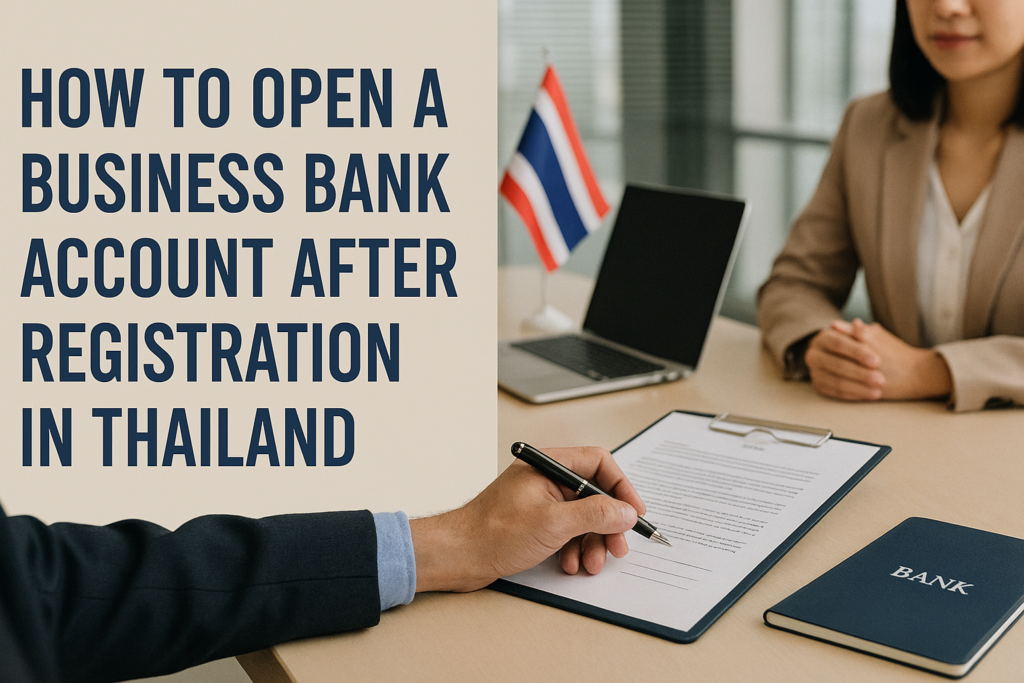🏦💼 Launching your business in Thailand? Congratulations! But wait, have you thought about how you’ll manage your finances? Opening a business bank account is a crucial step that many entrepreneurs overlook in their excitement.
Imagine this: You’ve registered your company, you’re ready to start operations, but suddenly you realize you can’t accept payments or manage your cash flow effectively. That’s where a Thai business bank account comes in. It’s not just a formality; it’s the financial foundation of your business in this vibrant Southeast Asian economy.
In this guide, we’ll walk you through the essentials of opening a business bank account in Thailand. From understanding the unique aspects of Thai banking to choosing the right institution for your needs, we’ve got you covered. We’ll explore the documentation you’ll need, the process you’ll follow, and how to maintain your account in compliance with local regulations. Let’s dive in and set your business up for financial success in the Land of Smiles! 🇹🇭💰
Understanding Thai Business Bank Accounts

Benefits of a dedicated business account
A dedicated business account offers numerous advantages for companies operating in Thailand:
- Financial organization
- Professional image
- Clear audit trail
- Access to business-specific services
| Benefit | Description |
|---|---|
| Financial organization | Separate personal and business transactions |
| Professional image | Enhance credibility with clients and partners |
| Clear audit trail | Simplify tax reporting and financial management |
| Business-specific services | Access specialized tools and support |
Legal requirements for foreign businesses
Foreign businesses in Thailand must adhere to specific regulations when opening a bank account:
- Obtain a Foreign Business License or Certificate
- Register with the Department of Business Development
- Provide proof of company registration and shareholder information
- Submit board resolutions authorizing account opening
Different types of business accounts available
Thai banks offer various account types to cater to different business needs:
- Current accounts
- Savings accounts
- Fixed deposit accounts
- Foreign currency accounts
| Account Type | Key Features |
|---|---|
| Current | Checkbook facility, no interest |
| Savings | Interest-earning, limited transactions |
| Fixed deposit | Higher interest rates, time-bound |
| Foreign currency | Multi-currency transactions |
Choosing the right account type depends on your business operations, cash flow needs, and financial goals. Now that we’ve covered the basics of Thai business bank accounts, let’s explore the documentation you’ll need to gather for the account opening process.
Gathering Necessary Documentation

A. Company registration certificate
To open a business bank account in Thailand, the first crucial document you’ll need is your company registration certificate. This official document, issued by the Department of Business Development (DBD), serves as proof of your company’s legal existence and registration in Thailand.
- Key details on the certificate:
- Company name
- Registration number
- Date of incorporation
- Registered capital
- Business objectives
B. Tax ID and VAT registration documents
Next, you’ll need to provide your company’s tax identification documents:
- Tax ID Certificate: Issued by the Revenue Department
- VAT Registration Certificate: Required if your business is VAT-registered
| Document | Issuing Authority | Purpose |
|---|---|---|
| Tax ID Certificate | Revenue Department | Unique identifier for tax purposes |
| VAT Registration | Revenue Department | Proof of VAT registration (if applicable) |
C. Passport copies of company directors
Banks require passport copies of all company directors to verify their identities and eligibility to operate a business in Thailand. Ensure that:
- Passport copies are clear and legible
- All pages with relevant information are included
- Copies are certified as true copies by the passport holders
D. Corporate bank account application form
Finally, you’ll need to complete the bank’s corporate account application form. This form typically requires:
- Company details (name, address, contact information)
- Directors’ information
- Type of account desired (e.g., savings, current)
- Authorized signatories
- Additional services required (e.g., online banking, credit facilities)
With these documents prepared, you’ll be well-equipped to move forward with choosing the right bank for your business needs. The next step involves researching and comparing different banks to find the one that best suits your company’s requirements.
Choosing the Right Bank

A. Comparing services and fees
When choosing a bank for your Thai business account, it’s crucial to compare services and fees across different institutions. Here’s a breakdown of key factors to consider:
| Service/Fee | What to Look For |
|---|---|
| Account maintenance fees | Lower monthly charges |
| Transaction fees | Competitive rates for deposits, withdrawals, and transfers |
| Minimum balance requirements | Lower or no minimum balance |
| Foreign currency exchange rates | Favorable rates for international transactions |
| Business loan options | Availability and terms of credit facilities |
| Merchant services | Cost-effective payment processing solutions |
Look for banks that offer fee waivers for maintaining higher balances or meeting certain transaction volumes. Some banks may also provide special packages for startups or SMEs.
B. Evaluating international transfer capabilities
For businesses engaged in international trade, efficient and cost-effective cross-border transactions are essential. Consider the following:
- SWIFT network access for global transfers
- Availability of multi-currency accounts
- Competitive exchange rates for foreign currency transactions
- Fees for incoming and outgoing international transfers
- Processing times for international payments
C. Assessing online and mobile banking features
In today’s digital age, robust online and mobile banking platforms are crucial for efficient business operations. Key features to look for include:
- Real-time account balance and transaction history
- Bulk payment processing
- Integration with accounting software
- Mobile check deposit
- Customizable alerts and notifications
- Strong security measures (e.g., two-factor authentication)
D. Considering branch locations and accessibility
While digital banking is convenient, physical branch access can still be important for certain services. Evaluate:
- Number and location of branches near your business
- Availability of relationship managers for business accounts
- ATM network coverage for cash deposits and withdrawals
- Extended banking hours or dedicated business banking centers
Remember, the ideal bank should offer a balance of competitive fees, robust international capabilities, advanced digital tools, and convenient physical access to meet your business needs in Thailand.
Navigating the Account Opening Process

Scheduling an appointment with the bank
To begin the account opening process, it’s crucial to schedule an appointment with your chosen bank. This can typically be done through the bank’s website, mobile app, or by calling their business banking department directly. When scheduling, be sure to:
- Specify that you’re opening a business account
- Mention you’re a foreign-owned company (if applicable)
- Request a Thai-English speaking representative (if needed)
Meeting with a business banking representative
During your appointment, you’ll meet with a business banking specialist. This meeting is your opportunity to:
- Discuss your business needs
- Ask questions about account features
- Understand fee structures
- Learn about additional services
| Topic to Discuss | Why It’s Important |
|---|---|
| Transaction limits | Ensures account meets business volume |
| Online banking features | Facilitates efficient account management |
| International transfer options | Crucial for foreign businesses |
| Credit facilities | Potential future financing needs |
Submitting required documents
Be prepared to submit a comprehensive set of documents. These typically include:
- Company registration certificate
- Company’s memorandum of association
- List of shareholders
- Board of directors’ resolution to open the account
- Passport copies of all directors
- Work permits (for foreign directors)
- Company seal (if applicable)
Completing necessary forms and signatures
You’ll need to fill out several forms, which may include:
- Account opening application
- Signature cards
- Foreign exchange declaration forms (for foreign-owned businesses)
- Tax forms
Ensure all directors listed on the company registration are present to sign these documents.
Waiting for account approval
After submitting all required documents and forms, the bank will review your application. This process can take anywhere from a few days to a couple of weeks. During this time, the bank may:
- Conduct background checks
- Verify document authenticity
- Request additional information if needed
Once approved, you’ll receive your account details and can start banking operations.
Initial Account Setup and Management

A. Making the minimum deposit
When opening your business bank account in Thailand, you’ll typically need to make a minimum initial deposit. This amount varies depending on the bank and account type but usually ranges from 10,000 to 50,000 THB. Here’s a comparison of minimum deposits for popular Thai banks:
| Bank | Minimum Deposit (THB) |
|---|---|
| Bangkok Bank | 10,000 |
| Kasikorn Bank | 20,000 |
| Siam Commercial Bank | 30,000 |
| TMB Bank | 50,000 |
It’s crucial to have this amount ready when you visit the bank to finalize your account opening.
B. Setting up online banking access
After making your initial deposit, the next step is to set up online banking access. This process typically involves:
- Requesting online banking credentials from your bank representative
- Downloading the bank’s mobile app or accessing their web portal
- Creating a username and strong password
- Setting up two-factor authentication for added security
Online banking allows you to manage your account efficiently, offering features like:
- Real-time balance checking
- Fund transfers
- Bill payments
- Transaction history viewing
C. Ordering checks and debit cards
Most Thai banks offer checks and debit cards for business accounts. When ordering these:
- Specify the number of checkbooks needed
- Request debit cards for authorized signatories
- Choose between Visa, Mastercard, or local network cards
- Set up PIN codes for each debit card
D. Understanding transaction limits and fees
Familiarize yourself with the account’s transaction limits and fee structure. Common fees to be aware of include:
- Monthly maintenance fees
- Transaction fees (e.g., wire transfers, ATM withdrawals)
- Minimum balance fees
- Foreign currency exchange fees
Be sure to ask your bank representative about any promotional offers or fee waivers for new business accounts. Understanding these aspects will help you manage your account effectively and avoid unnecessary charges.
Ensuring Compliance and Maintaining the Account

Regular reporting requirements
To maintain compliance with Thai banking regulations, businesses must adhere to strict reporting requirements. These often include:
- Monthly financial statements
- Annual tax returns
- Foreign exchange transaction reports
Failure to comply can result in penalties or account suspension. Here’s a breakdown of common reporting frequencies:
| Report Type | Frequency | Submission Method |
|---|---|---|
| Financial Statements | Monthly | Online portal |
| Tax Returns | Annually | Revenue Department |
| FX Transactions | As occurred | Bank branch |
Keeping company information up to date
Regularly updating your company information is crucial. This includes:
- Changes in company directors
- Alterations to business address
- Modifications in shareholding structure
Notify your bank promptly of any changes to avoid account restrictions.
Managing multiple signatories
Multiple signatories can enhance security and operational efficiency. Consider:
- Assigning different authority levels
- Implementing dual-control mechanisms
- Regularly reviewing and updating signatory lists
Adhering to anti-money laundering regulations
Thai banks strictly enforce anti-money laundering (AML) regulations. Businesses must:
- Implement Know Your Customer (KYC) procedures
- Report suspicious transactions
- Maintain detailed transaction records
Regular staff training on AML policies is essential to ensure ongoing compliance. By diligently following these guidelines, businesses can maintain a healthy relationship with their Thai bank and avoid potential legal issues.
Opening a business bank account in Thailand is a crucial step for entrepreneurs establishing their presence in the country. By understanding the requirements, gathering the necessary documentation, and carefully selecting the right bank, you can streamline the process and ensure a smooth setup for your business finances. Navigating the account opening process, initial setup, and ongoing management are essential aspects of maintaining a healthy financial foundation for your Thai business venture.
As you embark on this journey, remember that compliance with local regulations and maintaining your account in good standing are paramount. By following the steps outlined in this guide and staying informed about any changes in banking policies or regulations, you’ll be well-equipped to manage your business finances effectively in Thailand. Take the time to research your options, prepare thoroughly, and don’t hesitate to seek professional advice when needed to ensure a successful and hassle-free banking experience for your Thai business.

